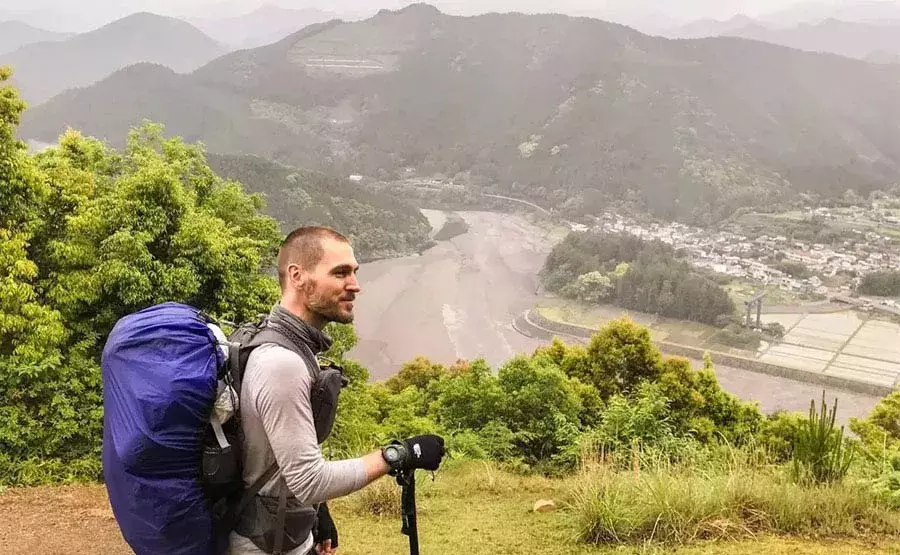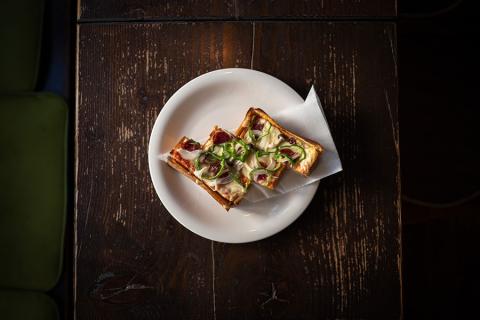
Craig Mod is an American based in Tokyo who walks many creative paths – both figuratively and literally. After studying as a college student at Waseda University, he stayed in Japan as the art director for a small indie press, and then became an independent writer, photographer, designer, and publisher. In recent years, he has been exploring the country on long walking journeys as part of his creative process.

He has published multiple books based on these walks, such as “Koya Bound: Eight Days on the Kumano Kodo” which documents a journey along the network of ancient pilgrimage trails in southern Kansai. His latest book “Kissa by Kissa” tracks a 1000 km walk along the Nakasendo highway in search of Japan’s beloved yet dwindling kissaten (old-fashioned coffee shops). In a brief conversation with JAPAN HOUSE Los Angeles, Mod shares some insight into his unique practice and some wisdom on how to pack for an epic walk.
You’ve created both analogue and digital (and “hybrid”) publishing projects. Do you think your perspective has been influenced by traditional Japanese book culture, and if so, how?
When I first arrived in Tokyo I used to hang out in Kinokuniya and marvel at the simplicity and restraint of all the book covers. And the sizes. They were beautiful in their rationality — sized for bags and pockets, not sized to yell on bookshelves. That had a big effect.
You’ve spoken about the value of “edges” and clearly defined boundaries in your work, be it a book, a website, a walk. Why do you feel these affordances are so important, and how do you observe them in Japanese design traditions?
As our digital world becomes more pervasive, we value stuff ending — having edges. I believe this happens intuitively. Books are great objects if you like edges! They allow the person engaging with the object to stop hyperventilating. I suspect most of us are amidst some form of hyperventilation whenever we engage with the online world. And so edges become forced meditations, or implicit meditations. I feel like Japan both understands the value in edges in most craftwork and mastery of craft, but also the porous endlessness of working in cycles, like with the cyclical rebuilding at Ise Grand Shrine. The local act has strong edges — rebuild the shrine — but the macro act is infinite.

What inspired you to start taking long walks in Japan, and why did you find them so important?
I started “seriously” walking when my friend John McBride invited me to walk the Kumano Kodo with him in 2014. I immediately recognized the value in it as a tool for thinking about or engaging with Japan and the world at large. John kept inviting me on more walks. And eventually I became confident enough to start doing it on my own.
How do you define a “long walk”?
A long walk could be a day — a walk up the Miura peninsula from Misaki Guchi to Kamakura. Or it could be three days along the Saba Kaido, or five days on the Kohechi from Koyasan southbound, or twenty-eight days along the Nakasendō. Or a few months from the tip of Hokkaido to the tip of Kyushu. Or years, in the case of Paul Salopek’s Out of Eden walk from Africa beyond. It’s a very relative thing.
How do you prepare for a long walk, from packing to mindset? Packing depends on infrastructure. Will I be hiking and camping?
That’s one big set of tools and potentially food. Otherwise, for most of the year in Japan, you can get away with a simple set of layered clothing. As for tech gear, 13” laptop, full-frame camera, Garmin watch for GPS tracking, iPhone. If I have those, I can work pretty much from anywhere, indefinitely.
What’s different about “walking culture” in the Japanese context, in contrast to other places you’ve walked? What’s different about walking a historic trade route like the Nakasendo Highway, as opposed to a more cultivated spiritual (and now touristic) pilgrimage path like the Kumano Kodo?
I haven’t walked that much elsewhere! I’ve done two weeks on the French and Portugese Camino in Spain, and loved it. That was extremely “collective” — like a roving shared walking experience (definitely not a “party,” per se, it transcended that mode in a really appealing way, felt genuinely spiritual). In Japan, hardly anyone else is doing long, historical walks so they’re far more solitary. I saw maybe one other person for most of the Nakasendō. The Kumano Kodo has dramatically risen in popularity in the last decade thanks to the promotional efforts of Tanabe City. It can be quite crowded. The vibe is different than the Camino since the Camino is built with crowds in mind. Kumano Kodo has far less infrastructure, so sometimes you simply can’t walk it because there are no available rooms.

The “trade route” walks in Japan are dire in a way I have come to love. Almost all road walking, a mix of big cities and highways and small towns. You have to tune your eye to the details of life and ignore the tractor trailers often flying by.
A route like the Ise-ji feels ideal in many ways — it’s a superb mix of small towns, farming villages, spirituality, and mountain passes. Eight days. A wonderful length. I prefer this kind of mixed walking to strict nature walks. I walked the Shinetsu Trail for six days along the ridgeline border of Nagano and Gunma but realized how much I missed the “life being lived” aspect. So I focus on walks that are connected to or enable a life being lived or having been lived.
What’s been the most unexpected discovery in your walks across Japan?
Just how much walking a person can do and not be sick of it. And the resilience of a body — how you can feel like your feet are bleeding, how you have no more skin on your toes, and you can keep going. And then get up the next day and keep going further. You realize how wimpy we are in most of our day-to-day lives — not in a macho or masculine way, but in a way that acknowledges how much excess or reserve we all carry within us. I think often about how that can be applied to the stiller days of a life.

Can you describe one of your latest long walks and how it was shaped by your love for kissaten and particularly, the classic kissa snack of “pizza toast”?
I wasn’t sure the Nakasendō walk would focus on kissaten until I was a few days into it. But then, it became evident that it was a good organizing principle since kissa would be present almost everywhere, no matter how small or desolate the town. A few years ago, I wrote extensively about the mini-pizza revolution that had been happening in Tokyo. It was only natural to keep going. Pizza toast is in some ways the “original” pizza of Japan, appearing decades before anything neapolitan-esque. Classic comfort food.
Your essay about this quest discusses the urban and demographic changes that are shrinking the number of classic kissaten that remain in Japan. Do you think kissaten will ever disappear, or simply transform?
Kissaten will never fully disappear. There’s too ever-present a love for them in contemporary Japanese society. Just look at the books (in Japanese) dedicated to helping fans discover the best kissa of Nagoya or Kyoto. Sure, many will disappear as any business or type of business does. But one could argue there were too many, at the peak. We’re seeing a mix of carrying forward the kissa torch in various ways — some folks, like the Asano sisters of Ran in Nagoya, took over an old kissa after the sudden death of an owner. Or Inoue-san of Mianto Coffee in Gifu. She studied at classic kissas and brought that spirit to her own coffee shop.
Where do you go to find inspiration in your daily life? Where do you go to break out of your daily life and patterns?
Walks! I live near mountains and the sea south of Tokyo. Early during the pandemic I did the same 8km loop dozens of times — up into the mountains and along a ridgeline with views out over the sea and of Mount Fuji. Phone off, camera in hand, even walking the same loop again and again you discover new details and delights. It’s a good way to sharpen the eye. You don’t need to go far to be inspired.






